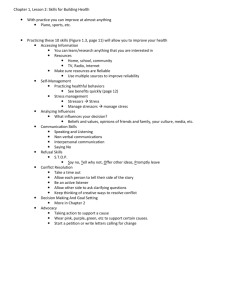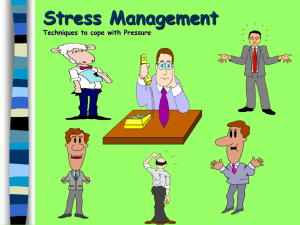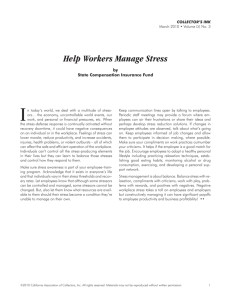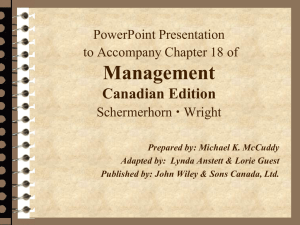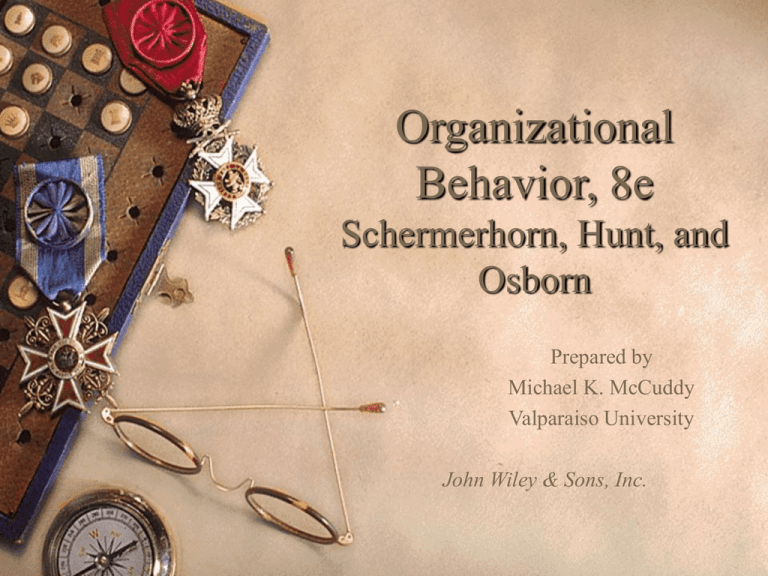
Organizational
Behavior, 8e
Schermerhorn, Hunt, and
Osborn
Prepared by
Michael K. McCuddy
Valparaiso University
John Wiley & Sons, Inc.
COPYRIGHT
Copyright 2003 © John Wiley & Sons, Inc. All rights reserved.
Reproduction or translation of this work beyond that permitted in Section
117 of the 1976 United States Copyright Act without the express written
permission of the copyright owner is unlawful. Request for further
information should be addressed to the Permissions Department, John Wiley
& Sons, Inc. The purchaser may make back-up copies for his/her own use
only and not for distribution or resale. The Publisher assumes no
responsibility for errors, omissions, or damages, caused by the use of these
programs or from the use of the information contained herein.
Organizational Behavior: Chapter 19
2
Chapter 19
Change, Innovation, and Stress
Study questions.
– What is organizational change?
– What change strategies are used in
organizations?
– What can be done about resistance to change?
– How do organizations innovate?
– How does stress affect people at work?
Organizational Behavior: Chapter 19
3
What is organizational change?
Forms of change.
– Radical change.
• Also known as frame-breaking change.
• Change that results in a major overhaul of the
organization or its component systems.
– Incremental change.
• Also known as frame-bending change.
• Change that is part of the organization’s natural
evolution.
Organizational Behavior: Chapter 19
4
What is organizational change?
Change agents.
– Individuals and groups who take responsibility
for changing the existing behavior patterns of
another person or social system.
– Sometimes hired as outside consultants.
– Managers and leaders in contemporary
organizations are expected to be change
agents.
Organizational Behavior: Chapter 19
5
What is organizational change?
Unplanned change.
– Occurs spontaneously or randomly.
– May be disruptive or beneficial.
– The appropriate goal is to act quickly to
minimize any negative consequences and
maximize any possible benefits.
Organizational Behavior: Chapter 19
6
What is organizational change?
Planned change.
– The result of specific efforts by a change
agent.
– A performance gap is a direct response to a
perceived performance gap.
• A discrepancy between the actual and desired state
of affairs.
• May reflect problems or opportunities.
Organizational Behavior: Chapter 19
7
What is organizational change?
Organizational forces for change.
– Organization-environment relationships.
– Organizational life cycle.
– Political nature of organizations.
Organizational Behavior: Chapter 19
8
What is organizational change?
Organizational targets for change.
– Purpose.
– Objectives.
– Strategy.
– Culture
– People.
– Tasks.
– Structure
– Technology.
Organizational Behavior: Chapter 19
9
What is organizational change?
Phases of planned change.
– Unfreezing.
• Preparing a situation for change by disconfirming existing
attitudes and behaviors.
• Susceptibility to “boiled frog phenomenon.”
– Changing.
• Taking action to modify a situation by altering the targets of
change.
– Refreezing.
• Maintaining and eventually institutionalizing the change.
Organizational Behavior: Chapter 19
10
What change strategies are
used in organizations?
Force-coercion strategy.
– Draws on reward power, coercive power, and
legitimate power as primary inducements to
change.
– Change agent acts unilaterally to command
change.
– Usually results in temporary compliance.
Organizational Behavior: Chapter 19
11
What change strategies are
used in organizations?
Rational persuasion strategy.
– Also known as an empirical-rational strategy.
– Draws on expert power as primary inducement
to change.
– Change agent uses special knowledge,
empirical support, or rational arguments.
– Usually results in long-term internalization.
Organizational Behavior: Chapter 19
12
What change strategies are
used in organizations?
Shared power strategy.
– Also known as a normative-reeducative
approach.
– Draws on referent power as primary
inducement to change.
– Change agent empowers people affected by
the change and involves them in decision
making related to the change.
– Usually results in long-term internalization.
Organizational Behavior: Chapter 19
13
What can be done about
resistance to change?
Resistance to change.
– Any attitude or behavior that indicates
unwillingness to make or support a desired
change.
– Alternative views of resistance.
• Something that must be overcome for change to be
successful.
• Feedback that can be used to facilitate achieving
change objectives.
Organizational Behavior: Chapter 19
14
What can be done about
resistance to change?
Why people resist change.
– Fear of the unknown.
– Lack of good information.
– Fear for loss of security.
– No reason to change.
– Fear for loss of power.
– Lack of resources.
– Bad timing.
– Habit.
Organizational Behavior: Chapter 19
15
What can be done about
resistance to change?
Ways in which resistance is experienced.
– Resistance to the change itself.
– Resistance to the change strategy.
– Resistance to the change agent.
Organizational Behavior: Chapter 19
16
What can be done about
resistance to change?
How to deal with resistance.
– Education and communication.
– Participation and involvement.
– Facilitation and support.
– Negotiation and agreement.
– Manipulation and cooptation.
– Explicit and implicit coercion.
Organizational Behavior: Chapter 19
17
What can be done about
resistance to change?
Education and communication.
– Educates people about change prior to
implementation and helps them understand the
logic of change.
– Use when people lack information or have
inaccurate information.
– Advantage — creates willingness to help with
the change.
– Disadvantage — can be very time consuming.
Organizational Behavior: Chapter 19
18
What can be done about
resistance to change?
Participation and involvement.
– Allows people to help design and implement
the changes.
– Use when other people have important
information and/or power to resist.
– Advantages — adds information to change
planning; builds commitment to change.
– Disadvantage — can be very time consuming.
Organizational Behavior: Chapter 19
19
What can be done about
resistance to change?
Facilitation and support.
– Provides emotional and material assistance for
people experiencing the hardships of change.
– Use when resistance traces to resource or
adjustment problems.
– Advantage — directly satisfies specific
resource or adjustment needs.
– Disadvantages — can be time consuming; can
be expensive.
Organizational Behavior: Chapter 19
20
What can be done about
resistance to change?
Negotiation and agreement.
– Offers incentives to actual or potential change
resistors.
– Use when a person or group will lose
something because of the change.
– Advantage — helps avoid major resistance.
– Disadvantages — can be expensive; can cause
others to seek similar deals.
Organizational Behavior: Chapter 19
21
What can be done about
resistance to change?
Manipulation and cooptation.
– Use covert attempts to influence others by
selectively providing information and
consciously structuring events.
– Use when other methods don’t work or are too
expensive.
– Advantages — can be quick and inexpensive.
– Disadvantage — can create future problems if
people sense manipulation.
Organizational Behavior: Chapter 19
22
What can be done about
resistance to change?
Explicit and implicit coercion.
– Employ the force of authority to implement
change.
– Use when speed is important and the change
agent has power.
– Advantages — quick; overpowers resistance.
– Disadvantage — risky if people get mad.
Organizational Behavior: Chapter 19
23
How do organizations innovate?
Innovation.
– The process of creating new ideas and putting them
into practice.
Product innovations.
– The introduction of new or improved goods or
services to better meet customer needs.
Process innovations.
– The introduction of new and better work methods and
operations.
Organizational Behavior: Chapter 19
24
How do organizations innovate?
The innovation process.
– Idea creation.
– Initial experimentation.
– Feasibility determination.
– Final application.
Organizational Behavior: Chapter 19
25
How do organizations innovate?
Features of innovative organizations.
– Strategies and cultures that are built around a
commitment to innovation.
– Structures that support innovation.
– Staffing with a clear commitment to
innovation.
– Top management support for innovation.
Organizational Behavior: Chapter 19
26
How does stress affect people at work?
Stress.
– A state of tension experienced by individuals
facing extraordinary demands, constraints, or
opportunities.
Organizational Behavior: Chapter 19
27
How does stress affect people at work?
Source of stress.
– Stressors.
• The wide variety of things that cause stress for
individuals.
– Types of stressors.
• Work-related stressors.
• Nonwork and personal stressors.
Organizational Behavior: Chapter 19
28
How does stress affect people at work?
Work-related stressors.
– Task demands.
– Role ambiguities.
– Role conflicts.
– Ethical dilemmas.
– Interpersonal problems.
– Career developments.
– Physical setting.
Organizational Behavior: Chapter 19
29
How does stress affect people at work?
Nonwork and personal stressors.
– Family events.
– Economic difficulties.
– Personal affairs.
– Individual’s needs.
– Individual’s capabilities.
– Individual’s personality.
Organizational Behavior: Chapter 19
30
How does stress affect people at work?
Stress and performance.
– Constructive stress.
• Also known as eustress.
• Moderate levels of stress act in a positive way for
both individuals and organization.
– Destructive stress.
• Also known as distress.
• Low and especially high levels of stress act in a
negative way for both individuals and organization.
Organizational Behavior: Chapter 19
31
How does stress affect people at work?
Stress can harm people’s physical and
psychological health.
– Health problem associated with stress.
•
•
•
•
•
•
•
•
•
Heart attack.
Stroke.
Hypertension.
Migraine headache.
Ulcers.
Substance abuse.
Overeating.
Depression.
Muscle aches.
Organizational Behavior: Chapter 19
32
How does stress affect people at work?
Key symptoms of excessive stress.
– Changes from:
• Regular attendance to absenteeism.
• Punctuality to tardiness.
• Diligent work to careless work.
• A positive attitude to a negative attitude.
• Openness to change to resistance to change.
• Cooperation to hostility.
Organizational Behavior: Chapter 19
33
How does stress affect people at work?
Stress prevention.
– The best first-line strategy in battling stress.
– Involves taking action to keep stress from
reaching a destructive level.
– Need to monitor personal and nonwork
stressors and to be proactive in preventing
their adverse impact.
Organizational Behavior: Chapter 19
34
How does stress affect people at work?
Stress management.
– Used once stress has reached a destructive
point.
– Begins with the recognition of stress
symptoms and continues with actions to
maintain a positive performance edge.
Organizational Behavior: Chapter 19
35
How does stress affect people at work?
Wellness.
– Personal wellness involves the pursuit of one’s
physical and mental potential through a
personal health promotion program.
– Recognizes individual responsibility for
maintaining and enhancing one’s physical and
mental health.
Organizational Behavior: Chapter 19
36


